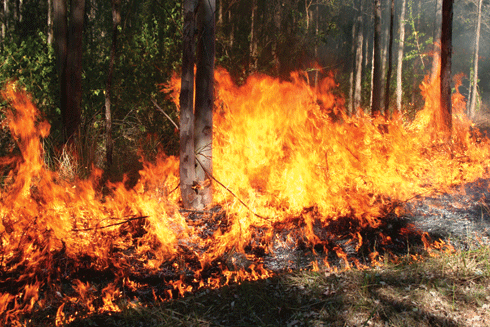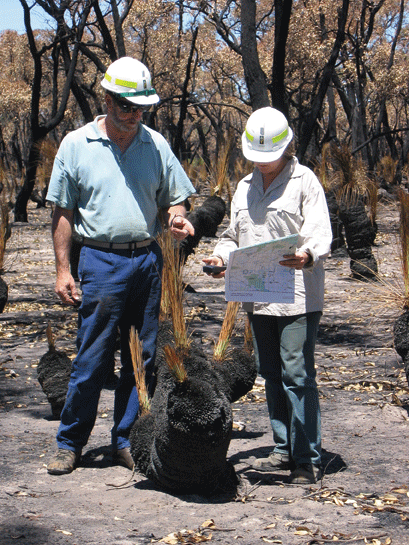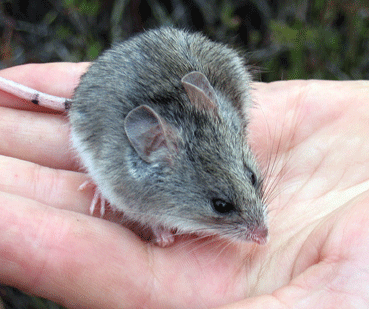
|
Published:
Managing fire’s impact on biodiversity
Management of fire prone areas is a difficult and contentious issue for land managers throughout Australia. As well as protecting human lives and property, they also face the challenge of managing for biodiversity outcomes and increasingly also the issue of conserving forest carbon.
The stringybark woodlands of south-west Victoria provide habitat for the endangered red-tailed black cockatoo (Calyptorhynchus banksii graptogyne). With only about 1000 birds remaining in Australia, the woodlands are managed to preserve the birds’ food resource of seeds in the tree canopy. Strip burning is mainly carried out on the edge of blocks, leaving most areas unburnt.
But how does this strategy affect other plant and animal species that inhabit the woodlands? Land managers in fire-prone areas all over Australia have to juggle similar issues when trying to develop optimal management regimes.
Dr Alan York, Senior Research Fellow at the University of Melbourne’s Department of Forest and Ecosystem Science, has investigated the impact of prescribed burning on wildlife in the woodlands. Using mapped fire histories, he and his colleagues investigated the role of time since the last fire (ranging from areas burnt within the last three years to areas unburnt for 25 years of more) and fire frequency (one, two or more fires in the last 40 years) on the area’s flora and fauna.
The extent to which the diversity of plant and animal species recovers after fire depends a lot on the nature of the fire regimes to which they are adapted. Dr York says their work has shown that most species living in these woodlands have evolved with a fairly regular fire regime.
‘They have responses that allow them to cope with fire although some species have a threshold so if you burnt four times over a 20-year period, you would start to see impacts.
‘This was important knowledge for the managers. Now they are trying to have more frequent but less severe fires so they can burn fuel on the ground without scorching the canopy.’
Chief Executive of the Australian Bushfire Cooperative Research Centre (CRC), Gary Morgan, says that for all land managers, the question of what the land is being managed for will determine whether or not they carry out prescribed burning.
He points out that sometimes and in some ecosystems, not burning will make areas more susceptible to wildfire. ‘We have seen cases internationally where forest health in national parks and timber reserves has declined after long periods without burning and they become more susceptible to the impact of a large wildfire.
‘The important factor is to have the land in a healthy state, with sufficient diversity so that the ecosystem has the ability to cope with a fire.’
For many ecosystems, such as the mountain ash (Eucalyptus regnans) forests which grow on the outer edges of Melbourne, and were the scene of the disastrous Black Saturday fires in February 2009, fire is a natural process that is needed to maintain the ecosystem. However, the natural frequency of fires may have been only once every several hundred years. In this type of ecosystem, more regular prescribed burning will result in a shift in vegetation and probably a change in biodiversity, says Bushfire CRC Program Leader Professor Rod Keenan.
Prof Keenan says that in areas where people live close to forests, prescribed burning may need to be carried out quite frequently and society must consider the trade-offs between protection of property and impacts on biodiversity.
While prescribed burning is often done to reduce the risk of wildfire, another management action – salvage logging – carried out after a bushfire, can also have impacts on biodiversity.
David Lindenmayer, Professor of Forest and Wildlife Management at the Australian National University, is concerned about the detrimental impacts of salvage logging. He says that despite the destruction they cause, high-intensity fires in mountain ash forests leave many kinds of biological legacies – numerous plant species survive and resprout after bushfires; large trees that remain, whether living or dead, contain hollows that provide nesting sites for marsupials and birds; and decaying logs on the forest floor become habitats for a range of animals and germination sites for plants such as tree ferns.
According to Prof Lindenmayer, salvage logging is having widespread impacts on biodiversity many times greater than the impact of wildfire alone.
‘Just like conventional clearfelling, salvage logging can result in the depletion or loss of these habitats, with flow-on negative effects on the biota that depend on them.
‘Removal of burned standing trees for example may hinder the build up of large pieces of coarse woody debris on the forest floor for decades.’
Prof Lindenmayer says that salvage logging after the 1939 bushfires has contributed to a shortage of cavity trees for more than 40 species of vertebrates that will take more than 200 years to rectify.
Another issue of increasing interest for forest managers, when considering whether to carry out prescribed burns or log burnt areas, is the issue of conserving forest carbon. Most of the carbon in a forest ecosystem is stored in big, old trees, large dead woody biomass and soil carbon.
Professor Brendan Mackey from the ANU Fenner School is involved in research being carried out at ANU to compare carbon stocks of forest sites before and after fires. Prof Mackey says most of this carbon is not combusted during even large intense fire. It is mainly litter, foliage, smaller twigs and branches, shrubs and young trees that are combusted.
‘Older trees can be killed by fire but that just means their carbon is ‘shifted’ from the living biomass carbon pool to the dead carbon biomass pool,’ says Prof Mackey. Although carbon is released into the atmosphere during a fire, this needs to be considered in terms of total forest ecosystem carbon stock and the annual sequestration rate of carbon into new biomass.
Preliminary modelling results from the Victorian Department of Sustainability and Environment show that CO2 emissions from the February 2009 bushfires, on public land, were more than 8.5 million tonnes.
Prof Keenan says significantly larger amounts were probably emitted from the bushfires in south-east Australia in 2003 and 2006–07, which were much more extensive fires and burnt more intensively over larger areas.
However, he says, most of these emissions usually come from leaves, the understorey and fine fuel on the forest floor, while about 60–70 per cent of carbon remains in the forest.
Professor Mackey and colleagues at ANU in their report Green Carbon argue that natural forests are more resilient to climate change and disturbances than plantations because of their biodiversity. This resilience includes regeneration after fire and adaptation to changes in radiation, temperature and water availability.
From the perspective of land managers, ecosystem health and human goals are often competing demands, but maintaining biodiversity, and hence ecosystem resilience, would seem to be important for both goals.
|
As people get on with the task of rebuilding their homes and their lives in Victoria’s fire-ravaged communities and new suburbs continue to expand on Melbourne’s fringe, the state is missing an opportunity to make communities more fire resistant, a Melbourne-based academic has warned. |
Bushfire CRC program leader Professor John Handmer, who is also director of the Centre for Risk and Community Safety at RMIT, says in the same way that people are discouraged from building in the worst flood-prone areas, action needs to be taken in high-risk fire areas. |
‘In fire areas we have the same sort of knowledge about places that are particularly high risk, for example due to the topography, such as north-facing, steep slopes but it is not being used,’ he says. Prof Handmer believes that building in some high-risk areas should be prohibited or the topography modified: for example, some people should be required to alter the grade of slopes they are building on to reduce the fire intensity to which the house is exposed. |
‘Bushfire-related building regulations help but would probably make little difference in extreme events,’ he says. |
Prof Handmer has studied the widely debated concept of community resilience. Although there are many different definitions, he says one important underlying feature of resilience is how connected people are in their community or neighbourhood. |
‘Our studies have shown that people who are well connected have a much better information flow about crises,’ he says. |
A second important element is money flow. ‘If you have steady income flow, whatever the source, then you have an enhanced resilience because you have a better capacity to deal with financial problems. |
‘Individual mobility is also a key factor. Up to 20 per cent of Australians have some disability and in many cases this limits mobility or stamina. Such limitations can affect people’s capacity to carry out aspects of fire preparedness and personal safety,’ says Prof Handmer. |
Prof Handmer believes that while Australian communities in bushfire-prone areas are resilient, they could be more so. ‘When you look at the recovery in Victoria, you can see that those communities are quite resilient, even in communities where many people died there is strong rebuilding, businesses recovering and a lot of social support. However, it doesn’t mean that in 20 years time the community will be significantly better prepared for fire,’ is his sobering warning. |




